從破敗重新釋放生命力
專案位於上海的市中心湖南路上,是一個頂層老公寓的翻新。
The project is located on Hunan Road in the center of Shanghai. It is the renovation of an old penthouse apartment.
▼從玄關望向室內,interior view from entrance © 李聖高子

空間規劃
Spatial Planning
將原始的非承重墻體去除後,幾扇滿眼綠意的窗戶瞬間映入眼簾,規劃上沒有特定的區域分割,保留東西向的視覺軸線,南北以壁爐作為餐廳和主客廳的隔斷。
After removing the original non-load-bearing walls, several windows filled with greenery instantly came into view. There was no specific area division in the planning, and the east-west visual axis was retained. A fireplace was used as a partition between the dining room and the main living room in the north and south.
▼以壁爐作為餐廳和主客廳的隔斷,the fireplace used as a partition between the dining and living room © 李聖高子
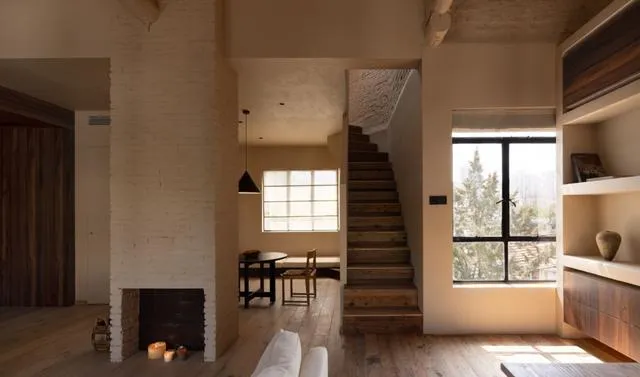

設計理念
Design concept
修舊如舊|Repair as before
拆下原來的青磚讓師傅事先保留下來,為後期的壁爐砌磚,用粘土去覆蓋的同時,將磚的紋路也保留下來,青磚側面依稀能看到當時窯廠燒制留下的紋樣,順著樓梯往上,還可以摸到舊的磚墻,觸覺上更是賦予這個房子感受時空交換的瞬間,主大廳屋頂的木梁也保留了原先的結構狀態,未重新吊頂,高闊的縱深感,將古樸不多加修飾的氛圍從另一維度的感官上加強,為此搭配深色混拼的煙熏木,跟黑色拉絲橡木,麻制軟布料,得以和諧共生。
The original blue bricks were removed and allowed to be preserved by the master in advance for laying bricks for the later fireplace. While covering them with clay, the texture of the bricks was also preserved. The patterns left by the kiln firing at that time can be seen vaguely on the sides of the green bricks. , going up the stairs, you can also touch the old brick walls, which gives this house a sense of time and space exchange. The wooden beams on the roof of the main hall also retain their original structural state, and have not been re-ceilinged. The high and wide The sense of depth enhances the simple and unadorned atmosphere from another dimension to the senses. For this reason, it is matched with dark mixed smoked wood, black brushed oak, and soft linen fabrics to achieve a harmonious symbiosis.
▼室內主大廳概覽,main living hall overview © 李聖高子
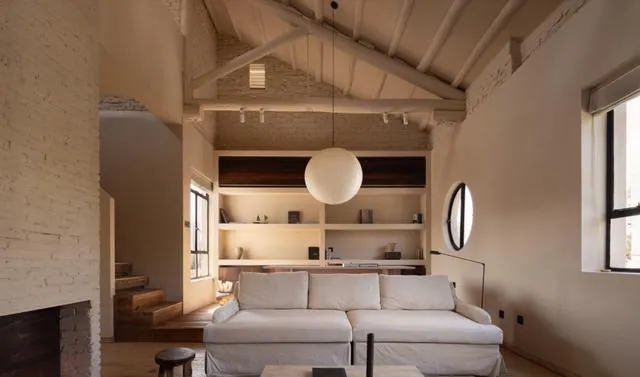
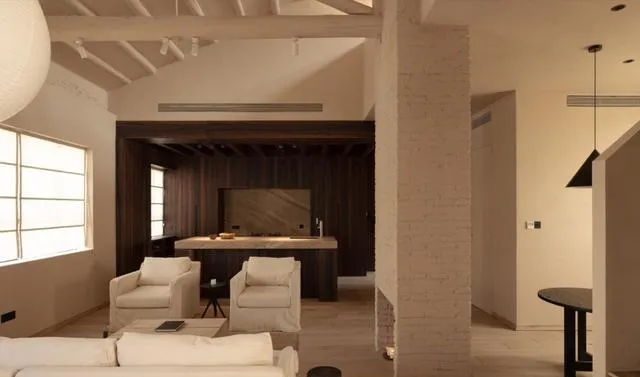
▼窗戶的綠意,The green in the window © 李聖高子
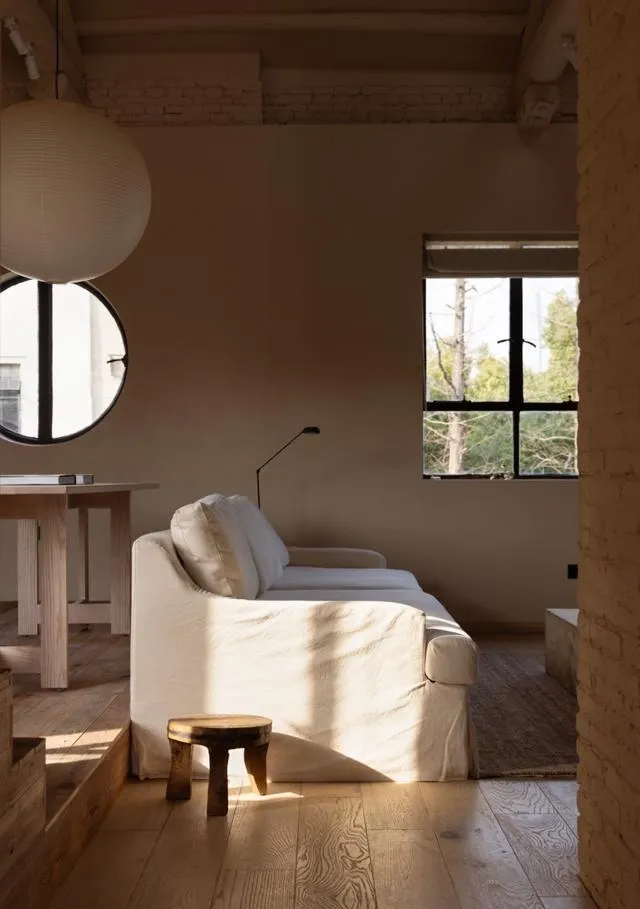
多維度的互動|Multi-dimensional interaction
城市中的邊界感給人以自有的約束,而在家裏,多場景的區域互動當是有互動,甚至是人人可參與,公區不需要有片墻去阻隔,大空間實作吧台操作區與廚房的互動,客廳與吧台操作的互動,客廳與餐廳的互動,客廳與書房的互動,更有二樓夾層公區與一樓公區的互動,客廳的最末端書桌區域地面與樓梯采用統一木材,以地台的形式連結一樓與二樓,這個高起的地台過渡空間情緒,也是另一種區域劃分的形式。
The sense of boundaries in the city gives people their own constraints, but at home, regional interaction in multiple scenes should be interactive, and even everyone can participate. Public areas do not need to be blocked by walls, and large spaces can realize bar operation areas. The interaction with the kitchen, the interaction between the living room and the bar operation, the interaction between the living room and the dining room, the interaction between the living room and the study room, and the interaction between the public area on the second floor mezzanine and the public area on the first floor. The floor and stairs of the desk area at the end of the living room are unified. Wood connects the first and second floors in the form of a platform. This raised platform transitions the mood of the space and is another form of regional division.
▼吧台操作區,bar area © 李聖高子
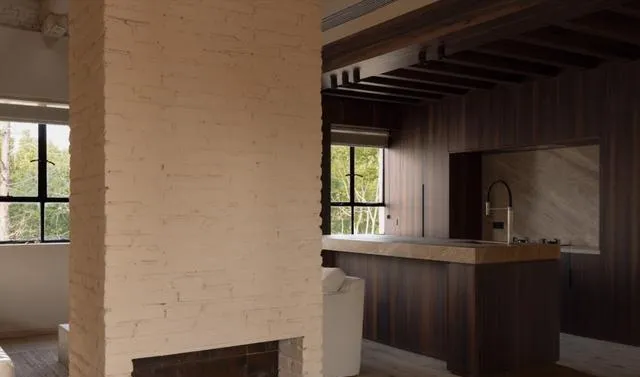
▼從吧台望向臥室,view from kitchen bar towards the bedroom © 李聖高子
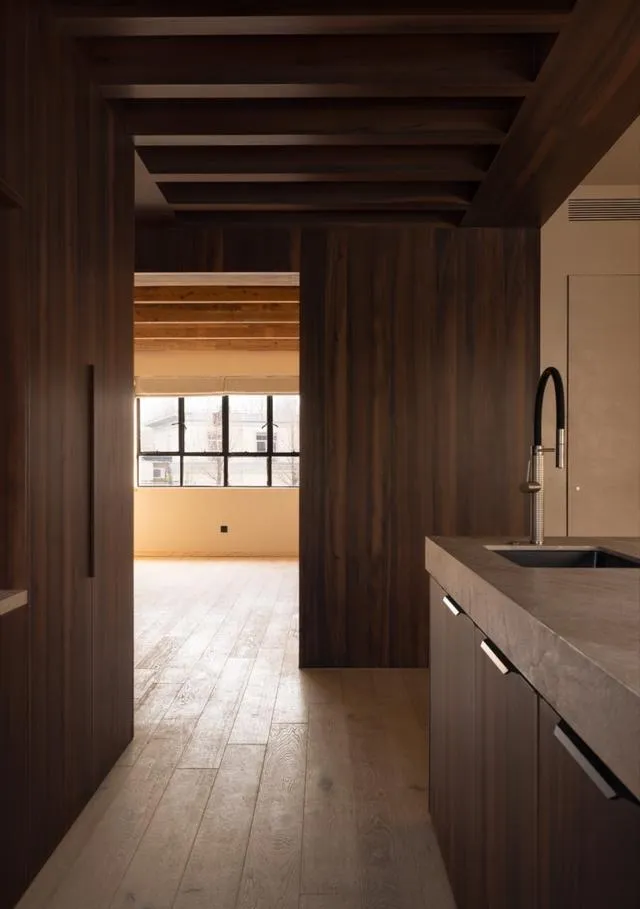
▼從臥室望向吧台,view from the bedroom bar towards the bar © 李聖高子
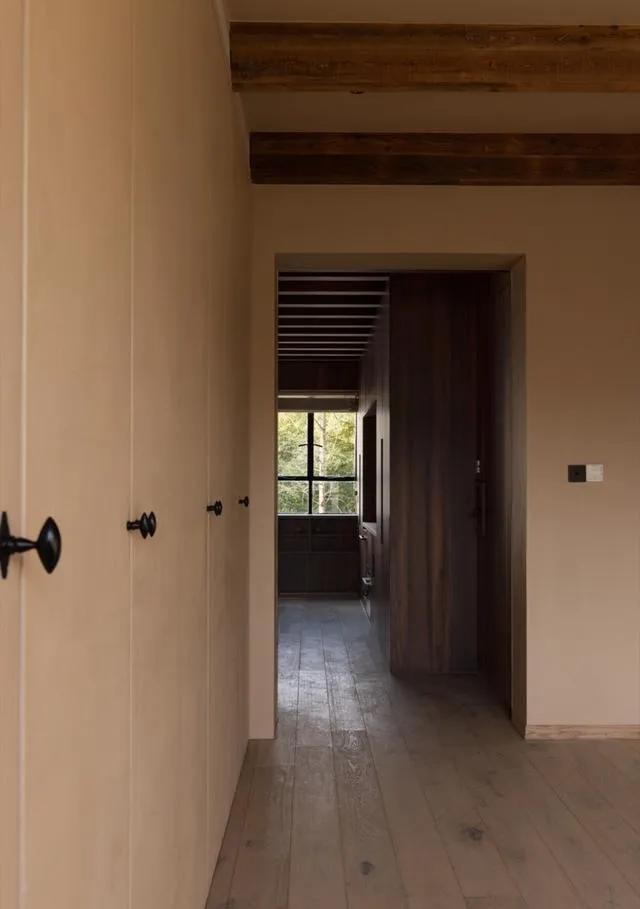
▼一瞥,a glimpse © 李聖高子
▼臥室,bedroom © 李聖高子


光在空間中的角色|The role of light in space
二樓的屋頂開啟了幾曬天窗,拉長的光影好似空間裏的舞者,在增加夾層空間的同時,賦予光的嫁衣,窗外雖處鬧市,但在浦西的這塊老城區層高都不高,往外只可望見紅紅的瓦頂及高大的松樹,投射進來的光線自然是足夠的,且飽滿。
Several skylights are opened on the roof of the second floor, and the elongated light and shadow are like dancers in the space. While increasing the mezzanine space, it also gives the wedding dress of light. Although the window is in a busy city, in this old city of Puxi, the skylights are high. It’s not high, and you can only see the red tile roof and tall pine trees. The light coming in is naturally enough and full.
▼夾層空間,the mezzanine space © 李聖高子
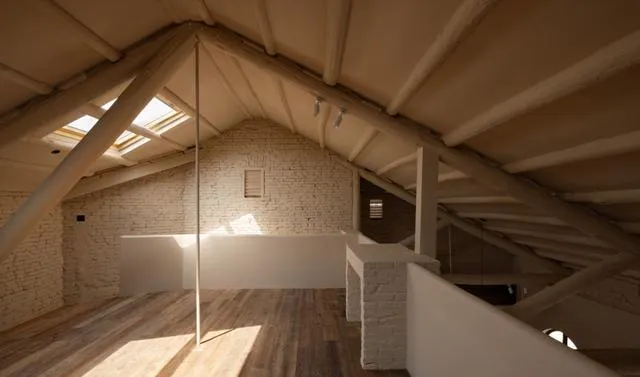
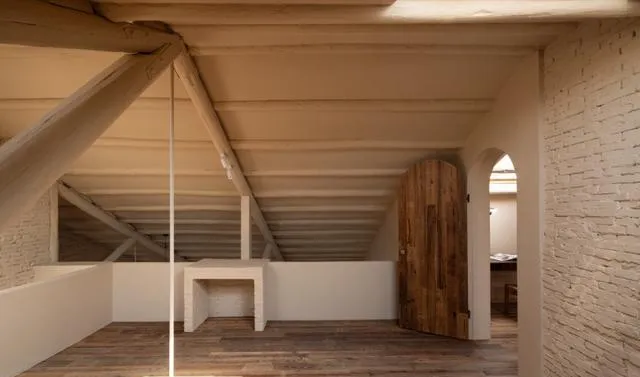
材質運用
Material use
好的居所一定能吸納人生活的痕跡,從而呈現出特定的豐富性,自然在這種情境下在材質的選擇上顯現滄桑古色 ,帶結巴的原木木地板,酸洗過的砂巖類石材,全屋的實木飾面選用的是蘋果木煙熏而成,透明的木蠟油毫不阻隔木材的天然感,包容在黏土質感的墻漆下,整個家氣質溫和,都源自自然的用色主張最終回歸於大地色系的沈穩。充分尊重材質肌理的墻面處理方式,帶來光影下的斑駁感,與磚的紋路相互承托使得質感進一步貼近自然。
A good residence must be able to absorb the traces of people’s life, thus showing a specific richness. In this situation, naturally, the vicissitudes of life will appear in the choice of materials, such as stuttering log floors, acid-washed sandstone stones, etc. The solid wood veneer of the house is made of smoked apple wood. The transparent wood wax oil does not block the natural feel of the wood. It is contained under the clay-textured wall paint. The whole home has a gentle temperament, which is derived from the natural color concept. Finally returns to the calmness of earth tones. The wall treatment method that fully respects the material texture brings a mottled feeling under light and shadow, and mutually supports the texture of the bricks, making the texture closer to nature.
▼自然的用色主張最終回歸於大地色系的沈穩,a gentle temperament that returns to the calmness of earth tones © 李聖高子

▼樓梯,staircase © 李聖高子
▼尊重材質肌理的墻面處理方式,wall treatment method fully respects the material texture © 李聖高子
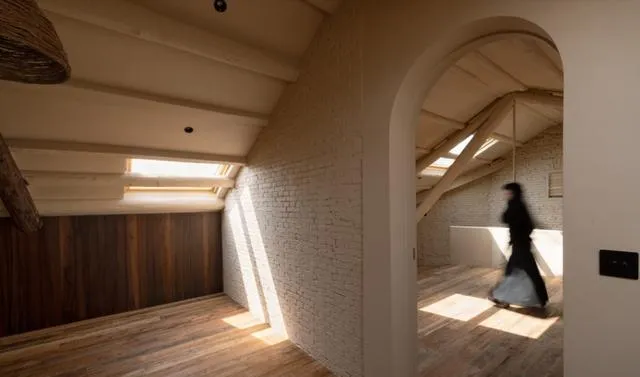
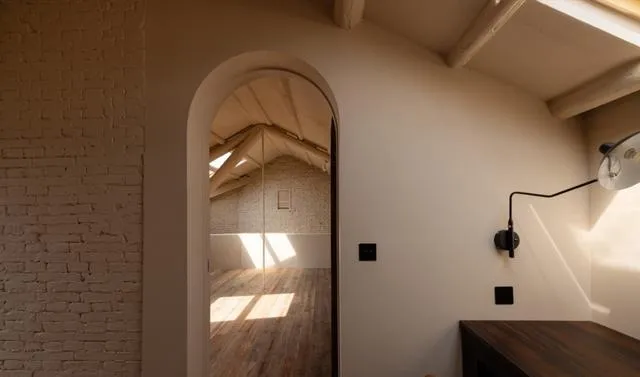
▼書房一角,a corner in the study © 李聖高子
大地色系中,一些黑色單品穿插於空間之內,以沈穩且經典的視覺印象為整個家裏的用色增加幾許層次感。棉麻也是自然居所的首選材質,刻意選擇的通透感窗簾,以更顯古意的折疊方式引光入室,沙發與床品借助棉麻的親膚感,營造生活更為妥帖與自然的形態。人居於此,如回歸自然,更如吸附在自然之中。
In the earth tones, some black items are interspersed in the space, adding a sense of layering to the color palette of the entire home with a calm and classic visual impression. Cotton and linen are also the preferred materials for natural residences. The transparent curtains are deliberately selected to bring light into the room with a more ancient folding method. The sofa and bedding use the skin-friendly feeling of cotton and linen to create a more appropriate and natural form of life. . Living here feels like returning to nature, or even more like being absorbed in nature.
▼黑色單品增加幾許層次感,some black items adding a sense of layering © 李聖高子
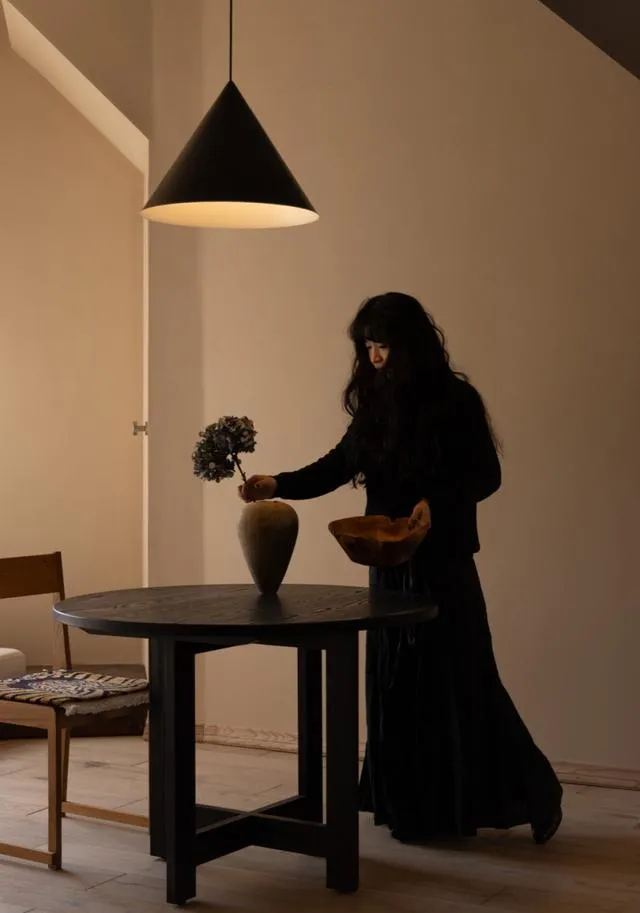

▼家具細節,items detail © 李聖高子
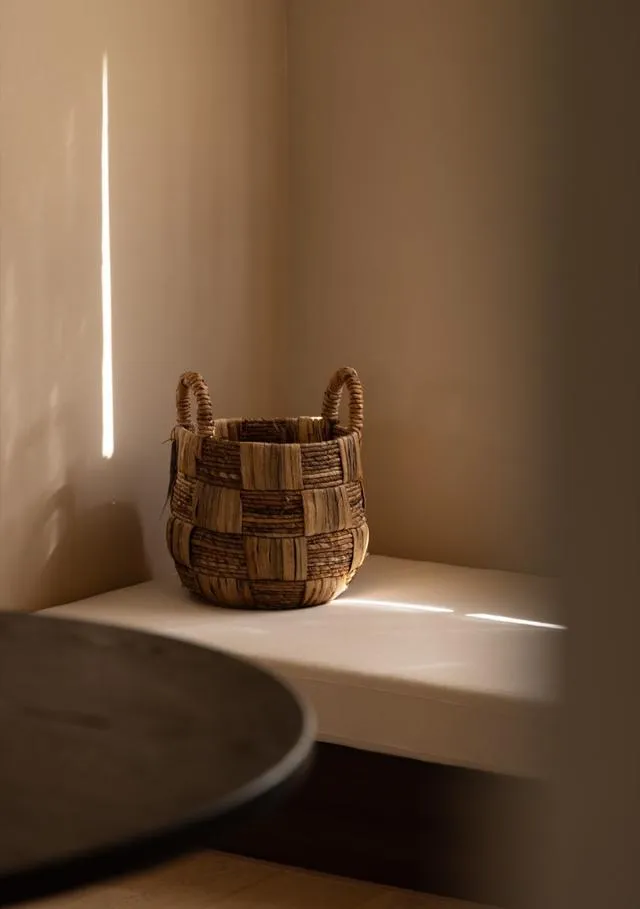
▼改造前平面,existed plan © 遊牧林工作室

▼改造後首層平面,1F plan after renovation © 遊牧林工作室
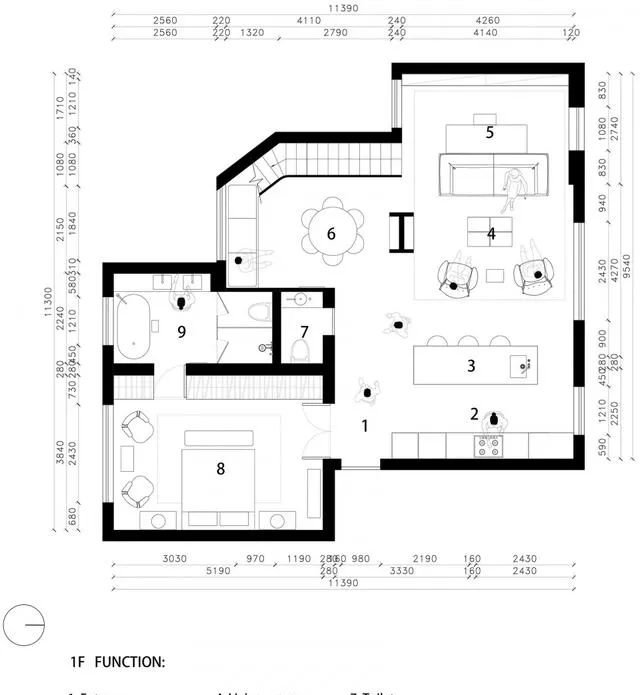
▼改造後二層平面,2F plan after renovation © 遊牧林工作室
▼原始剖面,original p © 遊牧林工作室
專案名稱:湖南路老房改造











